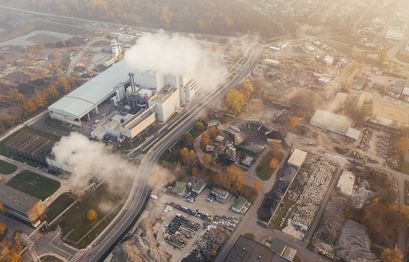- For countries to achieve their net-zero emissions, they must massively increase their uptake of carbon capture and storage technology (CCUS).
- High costs, technical challenges, and a lack of infrastructure limit CCUS uptake.
As the world becomes increasingly aware of climate change's dangers, more countries are committing to reducing their greenhouse gas emissions. Achieving net zero emissions by 2050 is quickly becoming the standard. Carbon capture, utilization and storage (CCUS) could be critical to meeting that goal.
BanklessTimes.com reports that countries must increase their CCUS uptake by 120 times by 2050 to achieve their net-zero commitments. This means reaching at least 4.2 gigatons of CO2 captured per annum. While this target may seem daunting, there is reason to be optimistic. CCUS technology is rapidly advancing, and with the right policies in place, we could see a considerable increase in its uptake in the coming years.
CCUS is one of the most promising technologies for achieving net zero emissions. It has the potential to significantly reduce greenhouse gas emissions from power plants and other industries. Several power plants and mining operations are already using the technology globally, which could be a game-changer in mitigating climate change. The challenge now is to scale up CCUS so it can be deployed at a large-scale. This will require significant investment and political will, but it is essential if we are to meet our climate goals.BanklessTimes CEO Jonathan Merry
CCUS involves capturing carbon dioxide emissions from power plants and other industrial facilities and storing them underground. This prevents the greenhouse gas from entering the atmosphere, where it would contribute to global warming. CCUS is already being used at a number of power plants and other industrial sites around the world, but its uptake has been limited by high costs, technical challenges, and a lack of infrastructure.
How Does CCUS Promote Net Zero Emissions?
There are several ways to use CCUS to reduce emissions. One is to store carbon dioxide emissions underground. Firms can do this through sequestration, where carbon dioxide is injected into an underground reservoir. Sequestration can help reduce emissions from power plants and other industrial sources, and it’s been used in many countries, including the United States, Canada, and Norway.
Another way to use CCUS is to convert carbon dioxide into other products. That is possible through carbon capture and utilization (CCU). With CCU, carbon dioxide is captured and then used to create products like fuel, plastics, or chemicals. Some countries like Germany and South Africa are already using CCU to stem greenhouse gas (GHG) emissions.
What are the Advantages Of CCUS?
First, it can help countries meet their emissions reduction goals. CCUS can reduce emissions from power plants significantly. In addition, CCUS can help offset emissions from other sectors like transportation and agriculture.
Second, CCUS can help make industries more sustainable. By capturing and using carbon dioxide, industries can reduce their reliance on fossil fuels and become more energy efficient. This reduces carbon emissions, helps improve air quality, and saves energy costs.
Third, CCUS can help promote innovation in green technologies. By providing a way to store carbon dioxide permanently, CCUS can help spur the development of new technologies that can reduce the impact of GHG on the environment. The technology could lead to significant advances in renewable energy sources and other green technologies.
Finally, CCUS can help build public support for climate action. By demonstrating that it is possible to reduce emissions while maintaining a thriving economy, CCUS can help persuade people to support measures to address climate change.
Challenges Facing CCUS Adoption
Despite these benefits, there are some challenges facing CCUS development. One obstacle is the cost of implementing CCUS technology. While the cost decreases over time, a significant financial investment is still required upfront. In addition, not all countries have the necessary infrastructure to support CCUS technology.
Another challenge is that CCUS technology is still relatively new. There is limited experience with implementing it at a large scale. And so, there are some uncertainties about how well it will work in practice.
Promising Future of CCUS
Although CCUS can potentially reduce GHG significantly, its uptake has been slow due to high costs and technical challenges. However, with the Paris Agreement committing countries to achieve net-zero emissions by 2050, governments are beginning to enact policies to support CCUS development.
In particular, the EU has pledged €3 billion to support CCUS research and deployment, while The United States recently passed the Inflation Reduction Act. This legislation includes an enhanced tax credit for CCUS facilities. Among others, it aims to spur investments in CCUS facilities to meet the needs of a net-zero society.
Contributors












